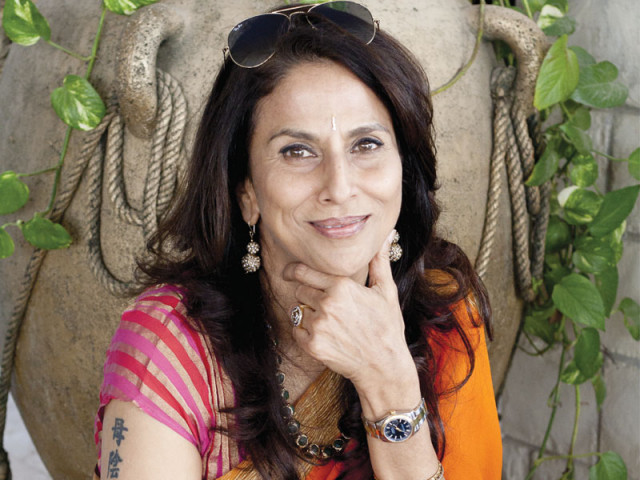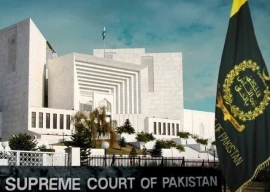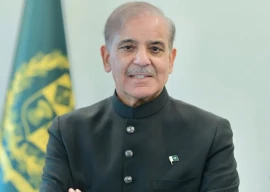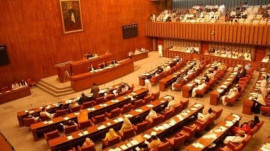
You either love her or hate her; when it comes to Shohbaa, there is no middle ground. There are no mild ‘she is nice’ or more serious ‘she’s deep and rather intense’ kind of comments after you mention her name. It’s all or nothing, much like Shohbaa herself.
I spoke to Shohbaa at the recently held Karachi Literature festival, soon after a small (and sparsely reported) verbal sparring match during her session. Concealed behind her glamourous and polite façade, I sensed a slightly edgy and standoffish undercurrent.
“You don’t need to interview me,” she quipped, “it’s already written in your head.” Clearly, this was not going to be a walk in the park.
Clad in a stylish deep purple long tunic with platform shoes, Shohbaa looked every bit a crowd-puller. I had seen her for two nights running and her choice of saris hadn’t particularly impressed me. Despite being a self-proclaimed Indophile, the fashion sense of our neighbours is not something that makes it to even the top 100 of my list of favourite things about the country. But the purple tunic Shohbaa was now wearing was a relief to my jaded eyes.
During this trip she publicly praised Karachi and even privately was heard praising the city a great deal. It sounded almost gushing (“I wasn’t gushing, I was appreciative,” she said, reacting sharply to my choice of words) compared to her impressions about Pakistan, (specifically Lahore) when she visited the city during the 1996 Cricket World Cup. Back then, she wrote a column ridiculing Lahoris which didn’t go down very well with the well heeled denizens of the city who had played host to her. So should Karachi expect a scathing Lahore-like column upon her return?
“Whenever I come back from Delhi I write a similar column (as the infamous Lahore piece),” she says. “These cities are a bit too feudalistic, hierarchical and parochial for my taste. Whereas in Karachi I feel much more myself, more accepted. It’s much more open, like Mumbai,” she concludes. “There are so many influences in Karachi which I don’t sense in Lahore.” She says she hopes to be pleasantly surprised when she goes back to Lahore now, as her previous column was a reflection of what she had seen and sensed 16 years ago. “My experiences both times in Karachi have been qualitatively different,” she pauses, smiles, and then adds, “happily so.”
She says she finds much more openness and movement between classes in Karachi. But it sounds strange to me that she mentions classes in an appreciative way. After all, she is the one who years ago ridiculed Govinda for bringing in class differences and emphasising the South-North Mumbai divide. This was in a Stardust interview, a magazine she launched and edited in the early 1970s. In it, she sounded like an absolute classist — the archetypal snobby South Mumbai town girl. Has age (she is 64 and the digits never looked better on any woman) softened her?
“That was a fabulous interview,” says Shohbaa. “The headline: ‘Class vs Masses’ was by the Stardust editorial team. I have consistently been a Govinda champion ever since he charmed me by throwing out the regular Stardust questionnaire. He said it was very mundane and he would like to talk to me directly. He was very disarming.” However, she defends the headline as a marketing gimmick to attract readers. “All of us editors, at one stage or the other, have done similar things to get readers to respond. Stardust was right to slot it in that manner.”
She finds being a classist ‘uncool’ in today’s world. “It doesn’t appeal to me. Crass behaviour has no class, it doesn’t matter where it’s coming from.”
So what does Shohbaa consider classy? “Refinement of mind,” she says, before I even ask the question. “And it has nothing to do with which level of society you are coming from, or your status and wealth. It’s something that is innate,” she elaborates.
However, her sense of superiority just cannot remain suppressed for long. It surfaces in one incident or the other. On Twitter, Shohbaa called Sonam Kapoor “ill brought up” when Sonam responded to Shohbaa’s scathing criticism of her work in I hate Love stories by calling her a “fossil” and “menopausal”.
As I raise this point, I see her hitherto relaxed body language becoming. I secretly curse myself for destroying the hard work of the last few minutes by putting her defences back up. “Is this an inquisition or what?” she says with agitation creeping into her voice. “I wrote that to call a woman ‘menopausal’ is ill brought up behaviour. After all, I am sure her mother will be menopausal at some stage. But then we moved on. I am not harping about it. I am not going to give her importance or attention. It’s a non-issue. You are making it an issue.”
We still have a lot of ground to cover so I decide to change the topic. She signals that our time is up, but I press on regardless.
It’s hard to nail down Shohbaa. Her novels are labelled “sleazy” and “pornographic” (as tweeted by Arbaz Khan after her searing review of Dabangg) or termed ‘raunchy’ and ‘racy’ by so-called literary circles. Her columns make fun of society and her film reviews are scathing, but her television appearances and blogs often highlight grave issues that are plaguing modern India.
One of those was about a Muslim boy not being able to get admission in South Mumbai colleges. Shohbaa then called up principals and managed to get him into one of the colleges. She wrote that earlier she was in a bubble and never gave credence to such ‘urban legends’ such as communal discrimination, but now it hit her as a bitter reality. Does Shohbaa then think communalism is on the rise in India?
“For every case of deprivation and prejudice, we have many good examples of communal harmony, equality, encouragement and secularism,” she counters.
She admits that there has been a change, which is that examples of bias are more articulated than in the past. But then she claims that Muslims in India are also to blame for non-assimilation and backwardness. To an extent I agree, having observed that there is a severe lack of education, along with a feeling of insecurity and a persecution complex prevailing among many Indian Muslims. “The persecution complex I understand,” says Shohbaa, “as minorities everywhere suffer from this. I am sure Hindus here do as well.”
Finally, I get the passionate, outspoken and relaxed Shohbaa De back. I silently vow not to rock the boat with any more questions that put her on the defensive and bring the interview to a premature end.
Warming to the topic, she relates an anecdote about Mohammad Ali Road, a very famous Mumbai neighbourhood populated by Muslims. She had been going to the locality for years to shop or to eat sumptuous food during Ramazan, typically dressed in jeans or a sari and sporting a bindiya on her forehead. She has also done shoots for local and international magazines in the area as it is one of the most visually interesting precincts of Mumbai.
But now things have changed, she laments. “I was doing a shoot there with a French photographer. I assure you that I was fully clad and there was nothing objectionable about the shoot. But I was spat on from balconies, told ‘we don’t want the likes of you in our area’ and physically chased out. I thought ‘what’s the point of trying?’ I stopped going there.” Disappointment tinges her tone as she reminisces.
She puts it down to a lack of education. “Only education and awareness can transform their lives and give a better life to coming generations.”
But does that bleak depiction apply to all Indian Muslims?
“I don’t mean to sound ‘classist’ but it is not so amongst people like us: the educated, enlightened, exposed ones,” she says.
But then, a change for the worse is found on the other side as well. The rise of Hindutva, hardline Hinduism, is a reality in today’s Shining India. More and more Muslims, and not just Muslims but people from UP, Kerala and Bihar, are targets of prejudice and xenophobia in Mumbai. Does Shohbaa believe this saffron extremism is on the rise?
“If Hindutva was rising Narendra Modi would have been a national hero and a contender for the top job, but he is not. He may have done a lot for the state, and God bless him for that, (did Shohbaa just bless a murderer?) and he remains a regional hero in Gujarat, but his appeal is not national.” Instead, she feels the Dalit vote will sway the next elections.
“I know I am putting myself on the line by stating this, but that’s a fact.”
She is confident that the young India is not interested in caste-based or rightist politics. “They just want prosperity, a better future, more jobs and stability. Anything based on a religious agenda and divisive politics is not a part of the future.”
Talking about young India brings to mind the rapid globalisation and westernisation that many say is distancing the youth from their cultural roots. Not everyone is delighted at the prospect, and while the vanguard of resistance is typically made up of hardline groups, even moderates like Vandana Shiva and Arundhati Roy have started voicing concern.
One glaring example of this ‘regressive progress’ is that many young Indian girls no longer know how to wrap a sari. This in a country that gave birth to this most sensual of garments!
“I think one generation is completely lost,” laments Shohbaa. “I speak to students about this, but I don’t want to be an auntyji who gives them bhashans and giyaan. It has to be illustrated to them that what they are losing out on is far more valuable than what they being seduced into,” she explains.
But hope is not lost. Shohbaa gives the example of her two daughters, who are 25 and 22. The younger daughter is far closer to her roots and finds traditions, saris and Indian culture attractive enough to explore and adopt.
“Clearly, the generation gap has been reduced to five to seven years because of technology and our fast changing world,” she quips.
Switching topics, I ask what she things about the omnipresent Indian soaps, chock full of Maan, Maryada and Mangalsutars? What about the bedecked women who are either saints or sinners and the men who are invariably spineless weasels? “It’s crazy!” she replies. “There seems to be a longing to recreate an era that existed perhaps hundreds of years ago. It’s all a ratings game,” she proclaims. “But still, it’s the only game in town till someone comes and changes the game.”
But we’re more than two decades into the Indian TV boom, I counter. Shouldn’t the hysteria have given way to some on-screen maturity by now? “Well, only a game changer can do that,” replies Shohbaa. “Ekta Kapoor did it in TV and recently in cinema. She made two hugely successful films which are different and bold in their content. But I don’t know if she would like to come back to TV as she is gravitating towards cinema,” she concludes.
The same hysterical pattern is seen in Indian news channels, I point out. “Yes, it’s shrieky and sobriety is missing. That’s why I don’t watch Hindi channels and only make appearances on TimesNow and CNN/IBN. After all, we can’t deny the fact television has a greater ability to put your point across.”
Again, she holds the ratings game responsible for the ever-increasing volumes of the armies of self-proclaimed small-screen pundits. “Anchors have the eyeballs, so they act like evangelists,” she says. Sounds painfully familiar, I think, as I run over a mental list of our own Pakistani anchors.
And the bad fashion that’s so visible on Indian TV screens? “Oh gosh, it’s a tsunami!” cries Shohbaa.
To me, Indian fashion seems to be stuck in a rut, and I say as much to her. “It’s because Indian fashion designers have still not been able to understand scale. They are still stuck in the boutique mentality,” she responds.
Once upon a time, she reflects, it was the ladies (whether from cinema or society) who used to dress their own way and bring individuality and diversity to fashion. “Now it’s the stylists who dictate fashion and rely heavily on designer brands. Therefore, there is no originality left.” She also holds foreign designers and high street brands responsible for the squeezing out of smaller designers. “The indigenous designers are fighting for survival,” she says.
Shohbaa’s much more generous in her praise for Pakistan fashion, especially our own little fashion wonder that’s known as lawn. “It’s fabulous!” she exclaims. “In fact, after this interview, I am going lawn shopping. It’s a luxury. I don’t know why it has not gone global as it can rock India, East Asia, the Gulf and even South America!” Music to my ears. Are you listening, Government of Pakistan, Trade Development authority of Pakistan and all you lawn-haters who start making ugly faces and noises every lawn season?
At this point, Shohbaa informs me that she’s getting late for her lawn shopping expedition and I realise that the interview is over. As I leave, I reflect that while her books may be the sizzling item numbers of the literary world, she herself sounds more like a social historian with her fingers firmly on the pulse of contemporary India.
From socio-political issues to religio-cultural topics, gender politics to bodypolitik, Shohbaa De eloquently describes and puts things in perspective like a historiographer. All that remains is for her to translate all this knowledge and understanding into a social history book or a novel about contemporary India—a book that makes her graduate from item number girl to a substantial, artistic, serious performer of the written word.
Published in The Express Tribune, Sunday Magazine, February 26th, 2012.


















COMMENTS
Comments are moderated and generally will be posted if they are on-topic and not abusive.
For more information, please see our Comments FAQ